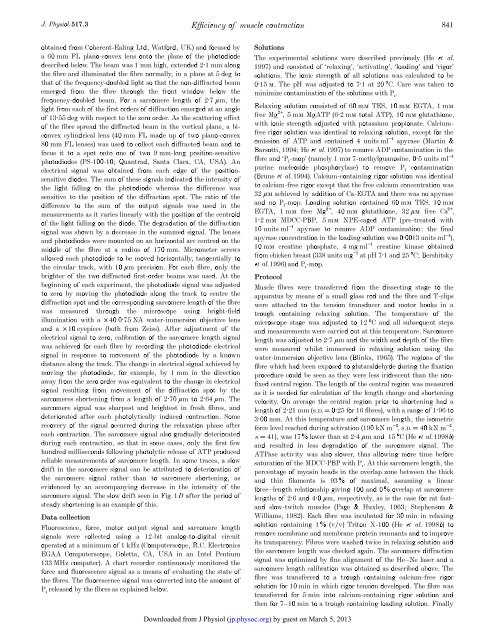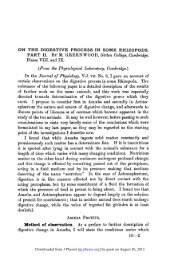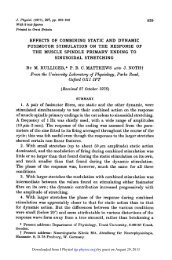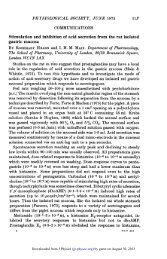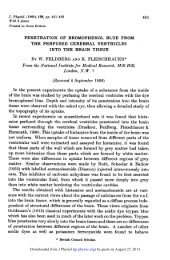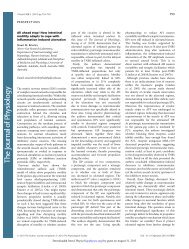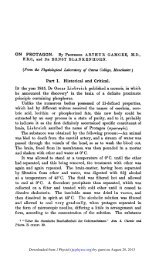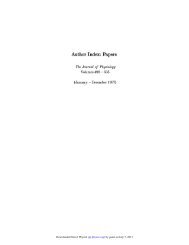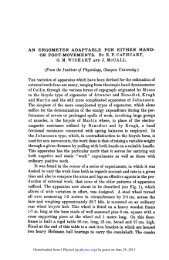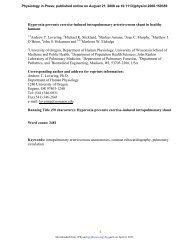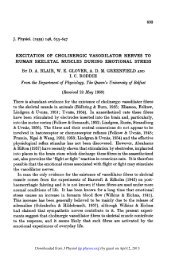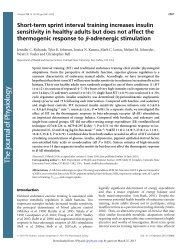The efficiency of contraction in rabbit skeletal muscle fibres ...
The efficiency of contraction in rabbit skeletal muscle fibres ...
The efficiency of contraction in rabbit skeletal muscle fibres ...
Create successful ePaper yourself
Turn your PDF publications into a flip-book with our unique Google optimized e-Paper software.
J. Physiol. 517.3 Efficiency <strong>of</strong> <strong>muscle</strong> <strong>contraction</strong><br />
841<br />
obta<strong>in</strong>ed from Coherent-Eal<strong>in</strong>g Ltd, Watford, UK) and focused by<br />
a60mm FL plano-convex lens onto the plane <strong>of</strong> the photodiode<br />
described below. <strong>The</strong> beam was 1 mm high, extended 2·1 mm along<br />
the fibre and illum<strong>in</strong>ated the fibre normally, <strong>in</strong> a plane at 5 deg to<br />
that <strong>of</strong> the frequency-doubled light so that the non-diffracted beam<br />
emerged from the fibre through the front w<strong>in</strong>dow below the<br />
frequency-doubled beam. For a sarcomere length <strong>of</strong> 2·7 ìm, the<br />
light from each <strong>of</strong> the first orders <strong>of</strong> diffraction emerged at an angle<br />
<strong>of</strong> 13·55 deg with respect to the zero order. As the scatter<strong>in</strong>g effect<br />
<strong>of</strong> the fibre spread the diffracted beam <strong>in</strong> the vertical plane, a biconvex<br />
cyl<strong>in</strong>drical lens (40 mm FL made up <strong>of</strong> two plano-convex<br />
80 mm FL lenses) was used to collect each diffracted beam and to<br />
focusittoaspotontoone<strong>of</strong>two9mm-long position-sensitive<br />
photodiodes (PS-100-10; Quantrad, Santa Clara, CA, USA). An<br />
electrical signal was obta<strong>in</strong>ed from each edge <strong>of</strong> the positionsensitive<br />
diodes. <strong>The</strong> sum <strong>of</strong> these signals <strong>in</strong>dicated the <strong>in</strong>tensity <strong>of</strong><br />
the light fall<strong>in</strong>g on the photodiode whereas the difference was<br />
sensitive to the position <strong>of</strong> the diffraction spot. <strong>The</strong> ratio <strong>of</strong> the<br />
difference to the sum <strong>of</strong> the output signals was used <strong>in</strong> the<br />
measurements as it varies l<strong>in</strong>early with the position <strong>of</strong> the centroid<br />
<strong>of</strong> the light fall<strong>in</strong>g on the diode. <strong>The</strong> degradation <strong>of</strong> the diffraction<br />
signal was shown by a decrease <strong>in</strong> the summed signal. <strong>The</strong> lenses<br />
and photodiodes were mounted on an horizontal arc centred on the<br />
middle <strong>of</strong> the fibre at a radius <strong>of</strong> 170 mm. Micrometer screws<br />
allowed each photodiode to be moved horizontally, tangentially to<br />
the circular track, with 10 ìm precision. For each fibre, only the<br />
brighter <strong>of</strong> the two diffracted first-order beams was used. At the<br />
beg<strong>in</strong>n<strong>in</strong>g <strong>of</strong> each experiment, the photodiode signal was adjusted<br />
to zero by mov<strong>in</strong>g the photodiode along the track to centre the<br />
diffraction spot and the correspond<strong>in</strong>g sarcomere length <strong>of</strong> the fibre<br />
was measured through the microscope us<strong>in</strong>g bright-field<br />
illum<strong>in</strong>ation with a ² 40 0·75 NA water-immersion objective lens<br />
and a ² 10 eyepiece (both from Zeiss). After adjustment <strong>of</strong> the<br />
electrical signal to zero, calibration <strong>of</strong> the sarcomere length signal<br />
was achieved for each fibre by record<strong>in</strong>g the photodiode electrical<br />
signal <strong>in</strong> response to movement <strong>of</strong> the photodiode by a known<br />
distance along the track. <strong>The</strong> change <strong>in</strong> electrical signal achieved by<br />
mov<strong>in</strong>g the photodiode, for example, by 1 mm <strong>in</strong> the direction<br />
away from the zero order was equivalent to the change <strong>in</strong> electrical<br />
signal result<strong>in</strong>g from movement <strong>of</strong> the diffraction spot by the<br />
sarcomeres shorten<strong>in</strong>g from a length <strong>of</strong> 2·70 ìm to 2·64 ìm. <strong>The</strong><br />
sarcomere signal was sharpest and brightest <strong>in</strong> fresh <strong>fibres</strong>, and<br />
deteriorated after each photolytically <strong>in</strong>duced <strong>contraction</strong>. Some<br />
recovery <strong>of</strong> the signal occurred dur<strong>in</strong>g the relaxation phase after<br />
each <strong>contraction</strong>. <strong>The</strong> sarcomere signal also gradually deteriorated<br />
dur<strong>in</strong>g each <strong>contraction</strong>, so that <strong>in</strong> some cases, only the first few<br />
hundred milliseconds follow<strong>in</strong>g photolytic release <strong>of</strong> ATP produced<br />
reliable measurements <strong>of</strong> sarcomere length. In some traces, a slow<br />
drift <strong>in</strong> the sarcomere signal can be attributed to deterioration <strong>of</strong><br />
the sarcomere signal rather than to sarcomere shorten<strong>in</strong>g, as<br />
evidenced by an accompany<strong>in</strong>g decrease <strong>in</strong> the <strong>in</strong>tensity <strong>of</strong> the<br />
sarcomere signal. <strong>The</strong> slow drift seen <strong>in</strong> Fig. 1D after the period <strong>of</strong><br />
steady shorten<strong>in</strong>g is an example <strong>of</strong> this.<br />
Data collection<br />
Fluorescence, force, motor output signal and sarcomere length<br />
signals were collected us<strong>in</strong>g a 12-bit analog-to-digital circuit<br />
operated at a m<strong>in</strong>imum <strong>of</strong> 1 kHz (Computerscope, R.C. Electronics<br />
EGAA Computerscope, Goletta, CA, USA <strong>in</strong> an Intel Pentium<br />
133 MHz computer). A chart recorder cont<strong>in</strong>uously monitored the<br />
force and fluorescence signal as a means <strong>of</strong> evaluat<strong>in</strong>g the state <strong>of</strong><br />
the <strong>fibres</strong>. <strong>The</strong> fluorescence signal was converted <strong>in</strong>to the amount <strong>of</strong><br />
Pé released by the <strong>fibres</strong> as expla<strong>in</strong>ed below.<br />
Downloaded from J Physiol (<br />
jp.physoc.org)<br />
by guest on March 5, 2013<br />
Solutions<br />
<strong>The</strong> experimental solutions were described previously (He et al.<br />
1997) and consisted <strong>of</strong> ‘relax<strong>in</strong>g’, ‘activat<strong>in</strong>g’, ‘load<strong>in</strong>g’ and ‘rigor’<br />
solutions. <strong>The</strong> ionic strength <strong>of</strong> all solutions was calculated to be<br />
0·15 Ò. <strong>The</strong> pH was adjusted to 7·1 at 20 °C. Care was taken to<br />
m<strong>in</strong>imize contam<strong>in</strong>ation <strong>of</strong> the solutions with Pé.<br />
Relax<strong>in</strong>g solution consisted <strong>of</strong> 60 mÒ TES, 10 mÒ EGTA, 1 mÒ<br />
free Mg¥, 5 mÒ MgATP (6·2 mÒ total ATP), 10 mÒ glutathione,<br />
with ionic strength adjusted with potassium propionate. Calciumfree<br />
rigor solution was identical to relax<strong>in</strong>g solution, except for the<br />
omission <strong>of</strong> ATP and conta<strong>in</strong>ed 4 units ml¢ apyrase (Mart<strong>in</strong> &<br />
Barsotti, 1994; He et al. 1997) to remove ADP contam<strong>in</strong>ation <strong>in</strong> the<br />
fibre and ‘Pé-mop’ (namely 1 mÒ 7-methylguanos<strong>in</strong>e, 0·5 units ml¢<br />
pur<strong>in</strong>e nucleoside phosphorylase) to remove Pé contam<strong>in</strong>ation<br />
(Brune et al. 1994). Calcium-conta<strong>in</strong><strong>in</strong>g rigor solution was identical<br />
to calcium-free rigor except that the free calcium concentration was<br />
32 ìÒ achieved by addition <strong>of</strong> Ca-EGTA and there was no apyrase<br />
and no Pé-mop. Load<strong>in</strong>g solution conta<strong>in</strong>ed 60 mÒ TES, 10 mÒ<br />
EGTA, 1 mÒ free Mg¥, 40 mÒ glutathione, 32 ìÒ free Ca¥,<br />
1·2 mÒ MDCC-PBP, 5 mÒ NPE-caged ATP (pre-treated with<br />
10 units ml¢ apyrase to remove ADP contam<strong>in</strong>ation: the f<strong>in</strong>al<br />
apyrase concentration <strong>in</strong> the load<strong>in</strong>g solution was 0·0013 units ml¢),<br />
10 mÒ creat<strong>in</strong>e phosphate, 4 mg ml¢ creat<strong>in</strong>e k<strong>in</strong>ase obta<strong>in</strong>ed<br />
from chicken breast (338 units mg¢ at pH 7·1 and 25 °C; Bershitsky<br />
et al. 1996) and Pé-mop.<br />
Protocol<br />
Muscle <strong>fibres</strong> were transferred from the dissect<strong>in</strong>g stage to the<br />
apparatus by means <strong>of</strong> a small glass rod and the fibre and T-clips<br />
were attached to the tension transducer and motor hooks <strong>in</strong> a<br />
trough conta<strong>in</strong><strong>in</strong>g relax<strong>in</strong>g solution. <strong>The</strong> temperature <strong>of</strong> the<br />
microscope stage was adjusted to 12 °C and all subsequent steps<br />
and measurements were carried out at this temperature. Sarcomere<br />
length was adjusted to 2·7 ìm and the width and depth <strong>of</strong> the fibre<br />
were measured whilst immersed <strong>in</strong> relax<strong>in</strong>g solution us<strong>in</strong>g the<br />
water-immersion objective lens (Bl<strong>in</strong>ks, 1965). <strong>The</strong> regions <strong>of</strong> the<br />
fibre which had been exposed to glutaraldehyde dur<strong>in</strong>g the fixation<br />
procedure could be seen as they were less iridescent than the nonfixed<br />
central region. <strong>The</strong> length <strong>of</strong> the central region was measured<br />
as it is needed for calculation <strong>of</strong> the length change and shorten<strong>in</strong>g<br />
velocity. On average the central region prior to shorten<strong>in</strong>g had a<br />
length <strong>of</strong> 2·21 mm (s.d. = 0·25 for 16 <strong>fibres</strong>), with a range <strong>of</strong> 1·96 to<br />
3·00 mm. At this temperature and sarcomere length, the isometric<br />
force level reached dur<strong>in</strong>g activation (190 kN m¦Â, s.d. =40kNm¦Â,<br />
n= 41), was 17% lower than at 2·4 ìm and 15°C (He et al. 1998b)<br />
and resulted <strong>in</strong> less degradation <strong>of</strong> the sarcomere signal. <strong>The</strong><br />
ATPase activity was also slower, thus allow<strong>in</strong>g more time before<br />
saturation <strong>of</strong> the MDCC-PBP with Pé. At this sarcomere length, the<br />
percentage <strong>of</strong> myos<strong>in</strong> heads <strong>in</strong> the overlap zone between the thick<br />
and th<strong>in</strong> filaments is 93 % <strong>of</strong> maximal, assum<strong>in</strong>g a l<strong>in</strong>ear<br />
force—length relationship giv<strong>in</strong>g 100 and 0 % overlap at sarcomere<br />
lengths <strong>of</strong> 2·6 and 4·0 ìm, respectively, as is the case for rat fastand<br />
slow-twitch <strong>muscle</strong>s (Page & Huxley, 1963; Stephenson &<br />
Williams, 1982). Each fibre was <strong>in</strong>cubated for 30 m<strong>in</strong> <strong>in</strong> relax<strong>in</strong>g<br />
solution conta<strong>in</strong><strong>in</strong>g 1 % (vÏv) Triton X-100 (He et al. 1998b) to<br />
remove membrane and membrane prote<strong>in</strong> remnants and to improve<br />
its transparency. Fibres were washed twice <strong>in</strong> relax<strong>in</strong>g solution and<br />
the sarcomere length was checked aga<strong>in</strong>. <strong>The</strong> sarcomere diffraction<br />
signal was optimized by f<strong>in</strong>e alignment <strong>of</strong> the He—Ne laser and a<br />
sarcomere length calibration was obta<strong>in</strong>ed as described above. <strong>The</strong><br />
fibre was transferred to a trough conta<strong>in</strong><strong>in</strong>g calcium-free rigor<br />
solution for 10 m<strong>in</strong> <strong>in</strong> which rigor tension developed. <strong>The</strong> fibre was<br />
transferred for 5 m<strong>in</strong> <strong>in</strong>to calcium-conta<strong>in</strong><strong>in</strong>g rigor solution and<br />
then for 7—10 m<strong>in</strong> to a trough conta<strong>in</strong><strong>in</strong>g load<strong>in</strong>g solution. F<strong>in</strong>ally


